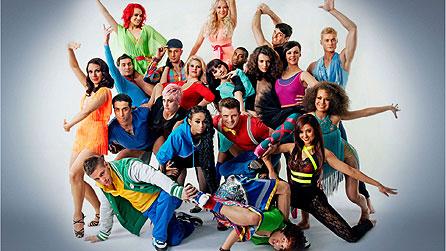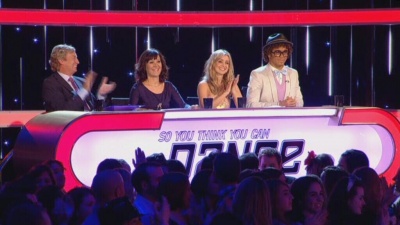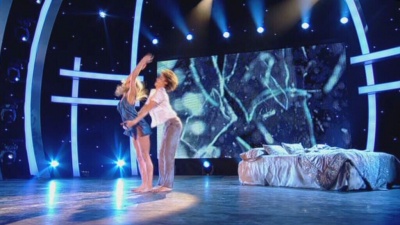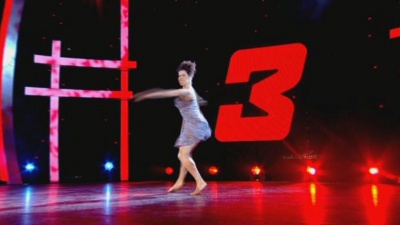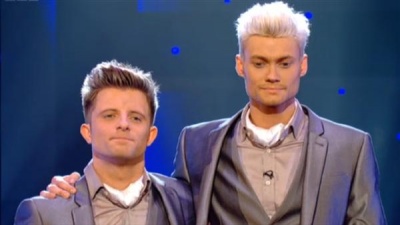So You Think You Can Dance
| (6 intermediate revisions not shown) | |||
| Line 1: | Line 1: | ||
<div class="image">[[File:Banner so you think you can dance.jpg]]</div> | <div class="image">[[File:Banner so you think you can dance.jpg]]</div> | ||
| + | |||
<div class=box> | <div class=box> | ||
| + | |||
== Host == | == Host == | ||
| Line 20: | Line 22: | ||
Back in 2005, the BBC attempted to extend its registered trademark ''Strictly'' brand with [[Strictly Dance Fever]], a competition for completely unknown dancers. It introduced [[Graham Norton]] to mainstream Saturday night audiences, and uncovered some terrific terpsichorean talent, but petered out after two series when the Corporation chose to give the time over to an [[Andrew Lloyd Webber]] promotion instead. | Back in 2005, the BBC attempted to extend its registered trademark ''Strictly'' brand with [[Strictly Dance Fever]], a competition for completely unknown dancers. It introduced [[Graham Norton]] to mainstream Saturday night audiences, and uncovered some terrific terpsichorean talent, but petered out after two series when the Corporation chose to give the time over to an [[Andrew Lloyd Webber]] promotion instead. | ||
| + | |||
| + | <div class=image>[[File:So You Think You Can Dance series 2.jpg]]''A new kind of pose called "Bhangra British"''</div> | ||
In effect, ''So You Think You Can Dance'' is Son of Strictly Dance Fever, though its key components - and personnel - can be traced right back through the generations to the earliest reality-talent hybrids, [[Popstars]] and [[Pop Idol]]. This isn't surprising, not just because the entire genre owes a huge debt to these pioneers, but also because SYTYCD (and what a superb acronym that isn't) is the creation of ''Stars'' judge "Nasty" Nigel Lythgoe, and ''Idol'' creator Simon Fuller. Having given birth to both ''Pop Idol'' and its descendant SYTYCD, Fuller has now technically become his own great-grandmother, which must be rather awkward at family get-togethers. | In effect, ''So You Think You Can Dance'' is Son of Strictly Dance Fever, though its key components - and personnel - can be traced right back through the generations to the earliest reality-talent hybrids, [[Popstars]] and [[Pop Idol]]. This isn't surprising, not just because the entire genre owes a huge debt to these pioneers, but also because SYTYCD (and what a superb acronym that isn't) is the creation of ''Stars'' judge "Nasty" Nigel Lythgoe, and ''Idol'' creator Simon Fuller. Having given birth to both ''Pop Idol'' and its descendant SYTYCD, Fuller has now technically become his own great-grandmother, which must be rather awkward at family get-togethers. | ||
| + | |||
| + | <div class=image>[[Image:So You Think You Can Dance judges.jpg|400px]]''Who thinks that this show should be renamed to "So You Think This Is Dubstep?"''</div> | ||
The format offers no huge innovation. Nationwide auditions see talented solo dancers aged from 18-35 (there is no upper age limit in the second series) given the opportunity to dance in front of a panel of experts. The 100 that impress are given a golden ticket to the Choreography Camp stage. Here, over three days, they are put through their paces by a group of choreographers you've never heard of, and some bloke off [[Strictly Come Dancing|Strictly]] before the field is narrowed to 14 dancers, who will compete in live Saturday night programmes in front of the judges and the viewing public. Here, two dancers (one "boy" and one "girl") are eliminated each week, until the winner is chosen and receives £100,000 and a chance to perform on the American version of the show. | The format offers no huge innovation. Nationwide auditions see talented solo dancers aged from 18-35 (there is no upper age limit in the second series) given the opportunity to dance in front of a panel of experts. The 100 that impress are given a golden ticket to the Choreography Camp stage. Here, over three days, they are put through their paces by a group of choreographers you've never heard of, and some bloke off [[Strictly Come Dancing|Strictly]] before the field is narrowed to 14 dancers, who will compete in live Saturday night programmes in front of the judges and the viewing public. Here, two dancers (one "boy" and one "girl") are eliminated each week, until the winner is chosen and receives £100,000 and a chance to perform on the American version of the show. | ||
| - | Although the show produces a single winner, the dancers mostly perform in pairs, with couples (always boy-girl, save for the final when all possible permutations perform) and dance styles allocated at random each week. Unlike Strictly Dance Fever, the couples are not asked to provide their own choreography but instead work with professional choreographers. Evidently these are top names in choreography; we can't claim to have heard of more than three or four, but then we can't be experts in ''everything'' - suffice it to say that the competitiors often seem genuinely starstruck when told who they'll be working with. | + | <div class=image>[[Image:So You Think You Can Dance modern.jpg|400px]]''How wrong.''</div> |
| + | |||
| + | Although the show produces a single winner, the dancers mostly perform in pairs, with couples (always boy-girl, save for the final when all possible permutations perform) and dance styles allocated at random each week. Unlike Strictly Dance Fever, the couples are not asked to provide their own choreography but instead work with professional choreographers. Evidently these are top names in choreography; we can't claim to have heard of more than three or four, but then we can't be experts in ''everything'' - suffice it to say that the competitiors often seem genuinely starstruck when told who they'll be working with. | ||
| + | |||
| + | <div class=image>[[Image:So You Think You Can Dance stage.jpg|400px|So You Think You Can Dance]]''The Recycled set from [[The People Versus]].''</div> | ||
The actual shows mostly follow the usual realitalent (and if anyone from the OED is reading this, we claim that as a neologism) template, with the odd tweak thrown in, or sometimes thrown out. The dancers dance in pairs, the judges judge in their infinite wisdom (but do not score), and the phone lines close in twenty minutes. The two couples with the least votes get to do 30-second solos (were it not for the fact that SYTYCD has been going in the States since 2005, we'd think Nige and Si were taking notes from [[The Underdog Show]]) and then the judges decide which two individuals to send packing. | The actual shows mostly follow the usual realitalent (and if anyone from the OED is reading this, we claim that as a neologism) template, with the odd tweak thrown in, or sometimes thrown out. The dancers dance in pairs, the judges judge in their infinite wisdom (but do not score), and the phone lines close in twenty minutes. The two couples with the least votes get to do 30-second solos (were it not for the fact that SYTYCD has been going in the States since 2005, we'd think Nige and Si were taking notes from [[The Underdog Show]]) and then the judges decide which two individuals to send packing. | ||
| + | |||
| + | <div class=image>[[Image:So You Think You Can Dance countdown.jpg|400px]]''3 seconds until a powercut happens.''</div> | ||
It's a well-honed format, tempered in the fires of the USA summer season, though the odd "American" edge could do with being blunted. Cat's declaration that "it's your top ''n'' dancers" always seemed a little too desperate to convince - it was perhaps defensible toward the end, but when she launched in with "it's your top 14 dancers" on the first live show before a single public vote had been cast, our immediate reaction was "who do you think you're kidding?". That aside, Cat remains a thoroughly likeable and natural presenter, reacts to what's going on rather than sticking slavishly to a script, and has good rapport with contestants, judges and audience. The judges, seated from left to right (in 2011, right to left) in descending order of insightfulness (from Nigel Lythgoe, both funny and wise, down to Sisco Gomez, who thinks everything is "amazing") are a mixed bag, but their criticism is largely constructive and almost never gratuitously cruel. | It's a well-honed format, tempered in the fires of the USA summer season, though the odd "American" edge could do with being blunted. Cat's declaration that "it's your top ''n'' dancers" always seemed a little too desperate to convince - it was perhaps defensible toward the end, but when she launched in with "it's your top 14 dancers" on the first live show before a single public vote had been cast, our immediate reaction was "who do you think you're kidding?". That aside, Cat remains a thoroughly likeable and natural presenter, reacts to what's going on rather than sticking slavishly to a script, and has good rapport with contestants, judges and audience. The judges, seated from left to right (in 2011, right to left) in descending order of insightfulness (from Nigel Lythgoe, both funny and wise, down to Sisco Gomez, who thinks everything is "amazing") are a mixed bag, but their criticism is largely constructive and almost never gratuitously cruel. | ||
| Line 42: | Line 54: | ||
== Web links == | == Web links == | ||
| - | [http://www.bbc.co.uk/programmes/b00tqkyx | + | [http://www.bbc.co.uk/programmes/b00tqkyx BBC programme page] |
[http://en.wikipedia.org/wiki/So_You_Think_You_Can_Dance_(United_Kingdom) Wikipedia entry] | [http://en.wikipedia.org/wiki/So_You_Think_You_Can_Dance_(United_Kingdom) Wikipedia entry] | ||
| Line 50: | Line 62: | ||
<div class="image">[[File:So You Think Tommy Charlie Bench.jpg|400px]]''Series 1 runner-up Tommy Franzén (left) and champion Charlie Bruce (right) performing on the first live show''</div> | <div class="image">[[File:So You Think Tommy Charlie Bench.jpg|400px]]''Series 1 runner-up Tommy Franzén (left) and champion Charlie Bruce (right) performing on the first live show''</div> | ||
| - | <div class=image>[[Image:So You Think You Can Dance matt luke.jpg|400px]]''Series 2 champion Matt Flint (left) and | + | <div class=image>[[Image:So You Think You Can Dance matt luke.jpg|400px]]''Series 2 champion Matt Flint (left) and runner-up Luke Jackson (right) waiting for the results.''</div> |
== See also == | == See also == | ||
Current revision as of 23:04, 26 December 2023
Contents |
Host
Co-hosts
Judges: Nigel Lythgoe, Arlene Phillips, Louise Redknapp, Sisco Gomez
Guest judges: Priscilla Samuels (2010 auditions), Alexandra Burke (2011 auditions), John Barrowman (stand-in for Nigel Lythgoe, episode 6, series 2)
Broadcast
19 Entertainment for BBC One, 2 January 2010 to 11 June 2011 (19 episodes in 2 series)
Synopsis
Back in 2005, the BBC attempted to extend its registered trademark Strictly brand with Strictly Dance Fever, a competition for completely unknown dancers. It introduced Graham Norton to mainstream Saturday night audiences, and uncovered some terrific terpsichorean talent, but petered out after two series when the Corporation chose to give the time over to an Andrew Lloyd Webber promotion instead.
In effect, So You Think You Can Dance is Son of Strictly Dance Fever, though its key components - and personnel - can be traced right back through the generations to the earliest reality-talent hybrids, Popstars and Pop Idol. This isn't surprising, not just because the entire genre owes a huge debt to these pioneers, but also because SYTYCD (and what a superb acronym that isn't) is the creation of Stars judge "Nasty" Nigel Lythgoe, and Idol creator Simon Fuller. Having given birth to both Pop Idol and its descendant SYTYCD, Fuller has now technically become his own great-grandmother, which must be rather awkward at family get-togethers.
The format offers no huge innovation. Nationwide auditions see talented solo dancers aged from 18-35 (there is no upper age limit in the second series) given the opportunity to dance in front of a panel of experts. The 100 that impress are given a golden ticket to the Choreography Camp stage. Here, over three days, they are put through their paces by a group of choreographers you've never heard of, and some bloke off Strictly before the field is narrowed to 14 dancers, who will compete in live Saturday night programmes in front of the judges and the viewing public. Here, two dancers (one "boy" and one "girl") are eliminated each week, until the winner is chosen and receives £100,000 and a chance to perform on the American version of the show.
Although the show produces a single winner, the dancers mostly perform in pairs, with couples (always boy-girl, save for the final when all possible permutations perform) and dance styles allocated at random each week. Unlike Strictly Dance Fever, the couples are not asked to provide their own choreography but instead work with professional choreographers. Evidently these are top names in choreography; we can't claim to have heard of more than three or four, but then we can't be experts in everything - suffice it to say that the competitiors often seem genuinely starstruck when told who they'll be working with.
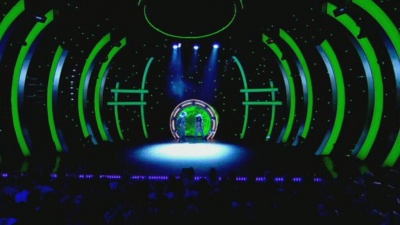 The Recycled set from The People Versus.
The Recycled set from The People Versus.The actual shows mostly follow the usual realitalent (and if anyone from the OED is reading this, we claim that as a neologism) template, with the odd tweak thrown in, or sometimes thrown out. The dancers dance in pairs, the judges judge in their infinite wisdom (but do not score), and the phone lines close in twenty minutes. The two couples with the least votes get to do 30-second solos (were it not for the fact that SYTYCD has been going in the States since 2005, we'd think Nige and Si were taking notes from The Underdog Show) and then the judges decide which two individuals to send packing.
It's a well-honed format, tempered in the fires of the USA summer season, though the odd "American" edge could do with being blunted. Cat's declaration that "it's your top n dancers" always seemed a little too desperate to convince - it was perhaps defensible toward the end, but when she launched in with "it's your top 14 dancers" on the first live show before a single public vote had been cast, our immediate reaction was "who do you think you're kidding?". That aside, Cat remains a thoroughly likeable and natural presenter, reacts to what's going on rather than sticking slavishly to a script, and has good rapport with contestants, judges and audience. The judges, seated from left to right (in 2011, right to left) in descending order of insightfulness (from Nigel Lythgoe, both funny and wise, down to Sisco Gomez, who thinks everything is "amazing") are a mixed bag, but their criticism is largely constructive and almost never gratuitously cruel.
Champions
2010: Charlie Bruce
2011: Matt Flint
Inventor
Simon Fuller and Nigel Lythgoe
Web links
Pictures
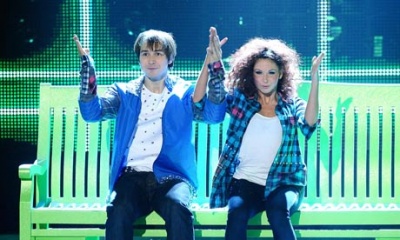 Series 1 runner-up Tommy Franzén (left) and champion Charlie Bruce (right) performing on the first live show
Series 1 runner-up Tommy Franzén (left) and champion Charlie Bruce (right) performing on the first live showSee also
Weaver's Week reviews: Series 1 and Series 2


